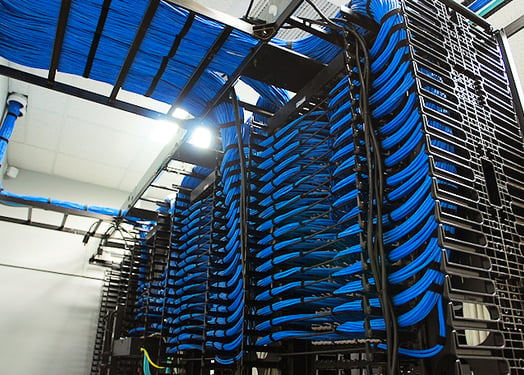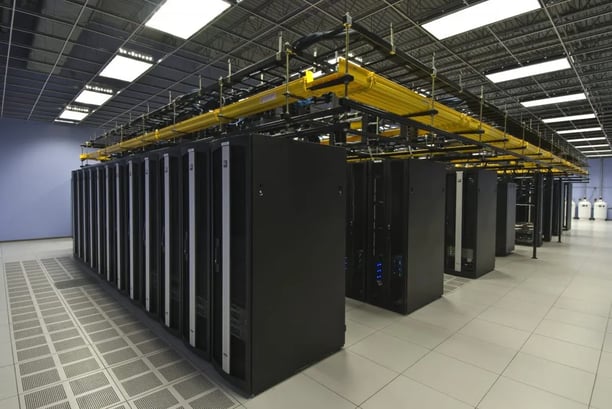Our services
From consulting and strategy development to implementation and support, our comprehensive services can help your business thrive.
Structured cabling is the backbone of modern communication networks, providing a robust and efficient foundation for voice, video, and data transmission. This standardized approach to cabling infrastructure offers a multitude of benefits that contribute to enhanced network performance, scalability, and security.
Core Advantages of Structured Cabling
Enhanced Reliability and Performance: Structured cabling employs high-quality components and adheres to industry standards, resulting in a network that is less prone to failures and delivers optimal performance for voice, video, and data applications.
Simplified Troubleshooting: The organized and structured nature of cabling systems makes fault identification and resolution significantly easier, minimizing downtime and increasing network availability.
Increased Scalability: Designed with future growth in mind, structured cabling can accommodate new devices, applications, and technologies without major disruptions or costly infrastructure overhauls.
Greater Flexibility: The modular components and standardized design of structured cabling allow for easy modifications, such as moving, adding, or changing network components, adapting to evolving business needs.
Cost-Effectiveness: By reducing downtime, simplifying management, and extending the life of the cabling infrastructure, structured cabling delivers long-term cost savings.
Enhanced Security: Structured cabling can be implemented to create secure network segments, limiting the impact of potential breaches. Additionally, it supports access control measures to protect sensitive data.


Structured Cabling
Network Optimization


Network optimization is a strategic process aimed at enhancing a network's performance, speed, and reliability. By identifying and addressing bottlenecks, it ensures optimal utilization of network resources, leading to a superior user experience.
Core Objectives of Network Optimization
Improved User Experience: Delivering seamless and responsive network performance for users, regardless of location or device.
Enhanced Network Performance: Accelerating data transfer speeds, reducing latency, and minimizing packet loss.
Increased Network Reliability: Ensuring consistent and uninterrupted network connectivity to prevent service disruptions.
Optimized Resource Utilization: Maximizing the efficiency of network components to reduce costs and improve performance.
Reduced Downtime: Minimizing network outages and service interruptions through proactive monitoring and maintenance.
Key Challenges Addressed by Network Optimization
Slowdowns: Addressing network congestion and latency to improve response times.
Latency: Reducing delays in data transmission to enhance application performance.
Congestion: Managing heavy traffic loads to prevent network overload and performance degradation.
Benefits of Network Optimization
Enhanced User Satisfaction: Providing a positive user experience through reliable and fast network connections.
Increased Productivity: Enabling efficient and uninterrupted workflow by eliminating network-related bottlenecks.
Cost Reduction: Optimizing network resources to lower operational expenses.
Competitive Advantage: Gaining a competitive edge by offering superior network performance.
Improved Business Continuity: Ensuring uninterrupted network services to minimize business disruptions.
Network Security


Network security is the cornerstone of modern business operations. It safeguards sensitive data, maintains operational continuity, and preserves organizational reputation. In an era marked by the relentless evolution of cyber threats, investing in robust network security solutions is no longer an option but a necessity.
The Growing Threat Landscape
The escalating cost of data breaches underscores the critical importance of proactive network security measures. With the projected increase from $3 million to $5 million per breach in 2024, the financial implications are staggering. Beyond monetary losses, data breaches can lead to irreparable damage to brand reputation, customer trust, and legal liabilities.
The Role of Network Security Solutions
Network security solutions serve as the first line of defense against cyberattacks. By implementing a comprehensive security strategy, organizations can:
Thwart unauthorized access: Prevent intruders from gaining entry into the network, safeguarding sensitive information and intellectual property.
Detect and intercept security breaches: Employ advanced technologies to identify and neutralize ongoing cyberattacks, minimizing potential damage.
Ensure secure access: Grant authorized users seamless and protected access to network resources, enhancing productivity and user experience.
The Business Imperative
Investing in network security is not solely about protecting data; it's about driving business success. A secure network:
Enhances security: Safeguards sensitive information, customer data, and intellectual property from theft, loss, or misuse.
Fosters business sustainability: Minimizes downtime, operational disruptions, and financial losses caused by cyberattacks.
Protects reputation: Builds trust with customers, partners, and stakeholders by demonstrating a commitment to data privacy and security.
Data Center Solutions


Data centers are the beating heart of modern organizations. Serving as centralized repositories for critical data and applications, they provide the foundation for efficient operations, innovation, and competitive advantage.
Managed Services
Disaster Recovery: Offering backup and recovery plans to protect data and systems.
Security Services: Providing cybersecurity measures, such as intrusion detection and prevention.
Data Center Management: Handling day-to-day operations, maintenance, and monitoring.
IP Telephony


Revolutionize Your Communications with IP Telephony
IP Telephony (VoIP) is a game-changer for businesses seeking to enhance efficiency, reduce costs, and improve customer satisfaction. By replacing traditional phone lines with internet-based communication, VoIP offers a host of advantages.
Experience Significant Cost Savings
Lower call rates: Enjoy substantial reductions in your monthly phone bills.
Eliminate long-distance charges: Say goodbye to costly long-distance calls.
Unleash Flexibility and Mobility
Make and receive calls from anywhere: Stay connected on the go with any internet-enabled device.
Enhance remote work capabilities: Empower your team to work efficiently from any location.
Boost Productivity and Customer Service
Access advanced features: Take advantage of call forwarding, voicemail-to-email, and call conferencing for streamlined operations.
Improve customer interactions: Provide exceptional support with enhanced communication tools.
Physical Security and Access Control


Our Physical Security and Access Control Solutions
We offers a comprehensive range of physical security and access control solutions tailored to your specific needs. Our services include:
Risk assessment: Evaluating your security vulnerabilities and developing a customized plan.
Access control systems: Implementing state-of-the-art access control technologies, such as key cards, biometric authentication, and video surveillance.
Surveillance systems: Installing high-definition cameras and advanced video analytics.
Alarm systems: Protecting your premises with intrusion detection and fire alarm systems.
Emergency response planning: Developing and implementing emergency procedures.
Security personnel: Providing trained security guards for added protection.
Solutions
© 2024. iQognite Business Solutions All rights reserved.
Al Hoora Dist, Manama,
Kingdom of Bahrain
Email: support@iqognite.com
